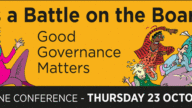Management & leadership, Governance, Marketing, Policy, campaigns & research
How DSC's publications transformed fundraising
From September to March, DSC is marking over 50 years of making charities stronger, please join us in the celebrations.
In 1983, we were running training courses and producing publications for the charity sector, always aiming to keep costs low so that smaller local charities could afford them. I began looking for a “magic bullet,” a publication that could generate real income while meeting a genuine need.
The Guide to Company Giving (1984)
The idea came to me to produce a guide listing the UK’s largest companies, detailing their charitable giving, who to apply to, and what they supported. I hired two out-of-work actors to cold call companies for information. I also wrote case studies and found valuable data through Extel, which published company charitable donation figures.
We pulled all of this together into the first edition of A Guide to Company Giving, published in 1984. It was an instant success, providing accessible information on company giving for the first time.
The Guide to the Major Trusts (1985)
Soon after, Luke FitzHerbert joined us to work on a new project: a comprehensive directory of major grant-making trusts. Our aim was to improve on existing resources by focusing on the 250 largest trusts and including detailed information on their policies, guidelines, and examples of past grants.
The first edition of A Guide to the Major Trusts was published in 1985, priced at £9.95. Despite pushback from some trusts, it marked a major step forward in transparency and access for fundraisers.
Luke’s work with the Henry Smith Charity, previously listed as giving only £4,000 annually, highlighted the importance of this effort. His persistence helped reveal the true scale of the trust’s giving and eventually led them to publish their own applicant guide.
Expanding the Series
Following the success of the major trusts guide, Luke was employed to compile further directories. The first two focused on grants for the Arts and for the Environment. These publications formed the foundation of what became an extensive series supporting fundraisers across the sector. Luke was integral to the success of DSC and had made a huge impact on the voluntary sector.


